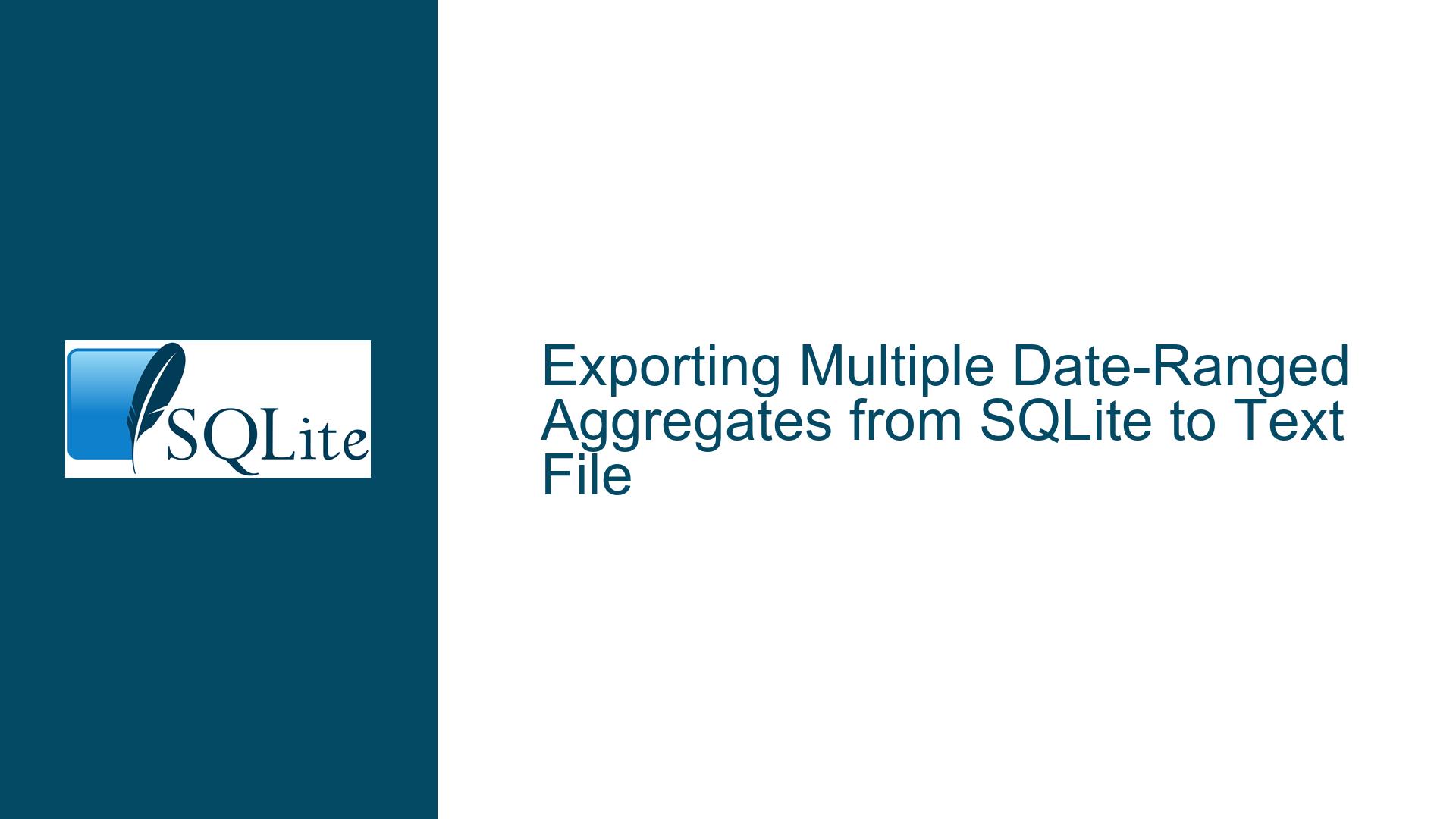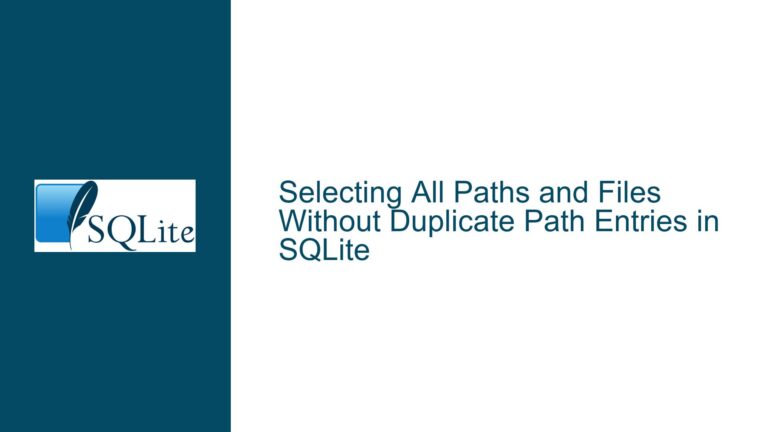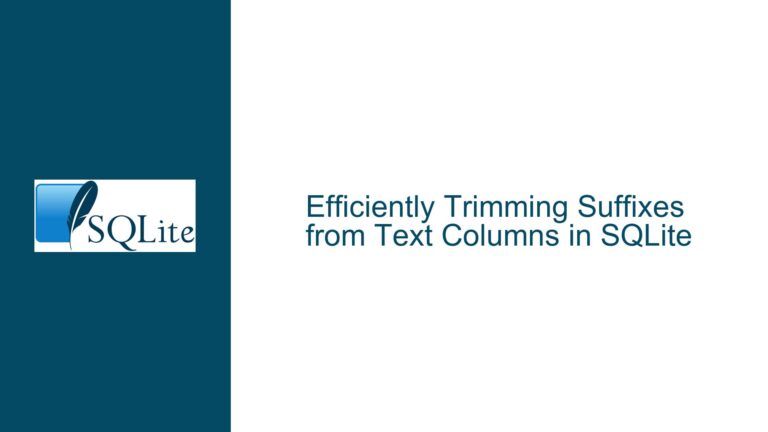Exporting Multiple Date-Ranged Aggregates from SQLite to Text File
Understanding SUM Syntax Ambiguity and Date Range Overlaps in Multi-Period Queries
Issue Overview
The core challenge involves efficiently querying monthly aggregates from a datetime-stamped energy consumption table and exporting those results cohesively. The original approach utilized 12 separate SELECT statements, each calculating SUM(ch1_amps_avg) * 215 / 1000 (representing kilowatt-hours) for non-overlapping monthly periods. However, this method presented three critical problems:
Syntax Ambiguity in Aggregation:
The expression(sum(ch1_amps_avg)_(215)/1000)initially appeared malformed due to missing operators (e.g.,*), though the user confirmed it executed correctly. This discrepancy arises from formatting issues in forum posts, where underscores or missing characters obfuscate the intendedSUM(ch1_amps_avg) * 215 / 1000.Date Range Overlaps and Boundary Handling:
UsingBETWEEN 'YYYY-MM-DD' AND 'YYYY-MM-DD'for consecutive months risks double-counting records if thedtcolumn stores dates without time components. For example,BETWEEN '2022-01-18' AND '2022-02-18'andBETWEEN '2022-02-18' AND '2022-03-18'both include February 18th. Ifdtincludes time (e.g.,2022-02-18 12:34:56), this isn’t an issue, but pure date values would overlap.Output Fragmentation Across Tools:
Executing multipleSELECTstatements in GUI tools like DB Browser for SQLite or the SQLite CLI often displays results sequentially, not tabulated. Exporting these to a text file without query unification yields disjointed data.
Root Causes of Query Fragmentation and Export Challenges
1. Misunderstanding SQLite’s Set-Based Logic
SQL operates on sets, but the original approach treated each monthly aggregation as a separate query. This reflects a procedural mindset (e.g., looping through months) rather than leveraging SQL’s ability to process all periods in a single statement.
2. Tool-Specific Output Limitations
GUI tools like DB Browser for SQLite prioritize interactivity over batch processing. While they allow query execution, exporting multi-resultset outputs to structured text isn’t always straightforward. The CLI’s .output command can redirect results, but without query consolidation, outputs lack context (e.g., which row corresponds to which month).
3. Schema and Data Type Assumptions
The dt column’s data type (pure DATE vs. DATETIME) directly impacts date range logic. Without ensuring time components, BETWEEN clauses risk inclusive overlaps. Additionally, the absence of a "period" identifier in results complicates interpreting exported data.
4. Syntax Ambiguities in Dynamic SQL
The missing * in SUM(...) (215)... highlights how forum formatting can mask true syntax. Valid SQL requires explicit operators, so SUM(ch1_amps_avg) * 215 / 1000 is correct. Misformatted posts can mislead responders, delaying resolution.
Unified Query Design, Date Handling, and Export Workarounds
Step 1: Resolve Syntax and Aggregation Logic
Ensure the Kilowatt-Hour Calculation Is Valid
Replace ambiguous (sum(ch1_amps_avg)_(215)/1000) with:
-- Explicit multiplication and division
SELECT (SUM(ch1_amps_avg) * 215) / 1000 AS kwh
FROM energy_history
WHERE ...;
Aliasing the result as kwh adds clarity to outputs.
Step 2: Eliminate Date Range Overlaps
Use Exclusive Upper Bounds
If dt is a DATE (without time), adjust ranges to exclude the upper bound:
WHERE dt >= '2022-01-18' AND dt < '2022-02-18'
For DATETIME values, ensure the upper bound is a time just before midnight:
WHERE dt >= '2022-01-18' AND dt < '2022-02-18 23:59:59.999'
Step 3: Consolidate Queries with UNION ALL
Combine Monthly Aggregations into a Single Resultset
SELECT
(SUM(ch1_amps_avg) * 215) / 1000 AS kwh,
'2021-12-26 to 2022-01-18' AS period
FROM energy_history
WHERE dt BETWEEN '2021-12-26' AND '2022-01-18'
UNION ALL
SELECT
(SUM(ch1_amps_avg) * 215) / 1000,
'2022-01-19 to 2022-02-18'
FROM energy_history
WHERE dt BETWEEN '2022-01-19' AND '2022-02-18'
-- Repeat for remaining periods with UNION ALL
Key Notes:
UNION ALLpreserves row order and is faster thanUNION(which deduplicates).- Include a
periodcolumn to identify each row’s time range.
Step 4: Dynamic Date Range Generation with Recursive CTE
Automate Month Series to Avoid Hardcoding
WITH RECURSIVE date_ranges(start_date, end_date) AS (
VALUES ('2021-12-26', '2022-01-18')
UNION ALL
SELECT
DATE(end_date, '+1 day'),
DATE(end_date, '+1 month', '+1 day')
FROM date_ranges
WHERE start_date < '2022-12-18'
)
SELECT
dr.start_date,
dr.end_date,
(SUM(eh.ch1_amps_avg) * 215) / 1000 AS kwh
FROM date_ranges dr
JOIN energy_history eh ON eh.dt BETWEEN dr.start_date AND dr.end_date
GROUP BY dr.start_date, dr.end_date
ORDER BY dr.start_date;
Adjustments for Fixed Day-of-Month Billing:
If billing cycles anchor to specific days (e.g., 18th of each month):
WITH RECURSIVE months(m) AS (
VALUES ('2021-12-18')
UNION ALL
SELECT DATE(m, '+1 month')
FROM months
WHERE m < '2022-12-18'
)
SELECT
m.m AS period_start,
DATE(m.m, '+1 month') AS period_end,
(SUM(eh.ch1_amps_avg) * 215) / 1000 AS kwh
FROM months m
JOIN energy_history eh ON eh.dt >= m.m AND eh.dt < DATE(m.m, '+1 month')
GROUP BY m.m;
Caution: DATE('2022-01-31', '+1 month') returns 2022-03-03 (Feb 31 isn’t valid). For end-of-month handling, use:
DATE(m.m, '+1 month', '-1 day')
Step 5: Exporting Results via SQLite CLI
Redirect Output to Text File
- CLI Workflow:
sqlite3 energy.db
.output yearly_kwh.txt
-- Paste the consolidated query here
.quit
- Formatting Outputs:
Enable column mode and headers for readability:
.headers ON
.mode column
Example output:
period_start period_end kwh
-------------------- -------------------- ----------
2021-12-26 2022-01-18 1234.56
2022-01-19 2022-02-18 1189.75
Step 6: GUI Tools (DB Browser) Export Options
- Execute Consolidated Query:
Run theUNION ALLor CTE-based query in the “Execute SQL” tab. - Export Results Grid:
- Right-click the results grid → Export → Table(s) to CSV/Text file.
- Uncheck “Column names” if headers aren’t desired.
- Automate via Scripting:
Use DB Browser’s “Log SQL” feature to record queries, then execute them viasqlite3CLI in batch mode:
sqlite3 energy.db < query.sql > yearly_kwh.txt
Step 7: Debugging Edge Cases
Validate Date Boundaries and Aggregates
- Spot-Check Overlaps:
Run a subquery to find records counted in multiple periods:
SELECT dt, COUNT(*) OVER (PARTITION BY dt) AS overlap_count
FROM energy_history
WHERE dt IN ('2022-01-18', '2022-02-18', ...);
- Handle NULLs in Aggregates:
Ifch1_amps_avgcontains NULLs,SUMignores them. To treat NULL as zero:
(SUM(COALESCE(ch1_amps_avg, 0)) * 215) / 1000
Final Solution Code Example
Combining CTE, Adjusted Date Ranges, and Export-Ready Formatting
.headers ON
.mode csv
.output yearly_kwh.csv
WITH RECURSIVE months(m) AS (
VALUES ('2021-12-18')
UNION ALL
SELECT DATE(m, '+1 month')
FROM months
WHERE m < '2022-12-18'
)
SELECT
m.m AS period_start,
DATE(m.m, '+1 month') AS period_end,
(SUM(COALESCE(eh.ch1_amps_avg, 0)) * 215) / 1000 AS kwh
FROM months m
JOIN energy_history eh
ON eh.dt >= m.m
AND eh.dt < DATE(m.m, '+1 month')
GROUP BY m.m
ORDER BY m.m;
Troubleshooting Table
| Symptom | Cause | Fix |
|---|---|---|
| Empty results | dt stored as TEXT not ISO | Recast dates: WHERE DATE(dt) BETWEEN ... |
| Incorrect kWh values | Missing * in SUM expression | Explicitly use SUM(...) * 215 / 1000 |
| Overlapping periods | BETWEEN with inclusive upper | Use dt >= start AND dt < end |
| Export missing data | GUI tool output row limit | Use CLI redirection or batch scripts |
| NULL in kWh | All ch1_amps_avg NULL in period | Check data quality or use COALESCE |
By addressing syntax clarity, date logic, and output unification, users can efficiently generate and export time-range aggregates without fragmentation.






